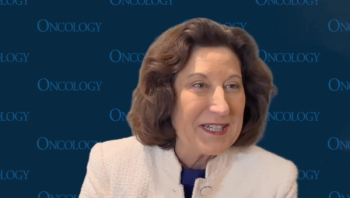
Nab-Paclitaxel No Better Than Paclitaxel in High-Risk Breast Cancer
No difference was found in pathologic complete response rates between neoadjuvant paclitaxel and nab-paclitaxel in women with ERBB2/HER2-negative breast cancer.
The phase III ETNA trial found no difference in pathologic complete response (pCR) rates between neoadjuvant paclitaxel and nab-paclitaxel in women with ERBB2/HER2-negative breast cancer.
Sequential anthracycline and taxane therapy are standard as adjuvant therapy for high-risk breast cancer, and the addition of a taxane to an anthracycline has also shown a doubling in the rate of pCR in the neoadjuvant setting.
“Data from reports in metastatic breast cancer indicated that nab-paclitaxel, the nano-particle, albumin-bound paclitaxel, has improved antitumor activity [compared with] solvent-based paclitaxel, although this superiority was not confirmed in a more recent trial,” wrote study authors led by Luca Gianni, MD, of the San Raffaele Scientific Institute in Milan. The different formulation allows for infusion of the agent without steroid premedication that is otherwise required.
This trial directly compared nab-paclitaxel and paclitaxel in the neoadjuvant setting in 695 patients (346 nab-paclitaxel, 349 paclitaxel) with newly diagnosed ERBB2/HER2-negative breast cancer. The median age of participants was 50 years, and most (72%) had clinical T2 tumors; 24% had locally advanced disease, and 32% were triple-negative. Results of the study were
The rate of pCR was improved with nab-paclitaxel, but this did not reach significance. The pCR rate with nab-paclitaxel was 22.5%, compared with 18.6% with paclitaxel, for an odds ratio (OR) of 0.77 (95% CI, 0.52–1.13; P = .19). The researchers pointed out that a high rate of pCR was achieved by those with triple-negative tumors, regardless of whether they received nab-paclitaxel (41.3%) or paclitaxel (37.3%).
A multivariate analysis showed that tumor subtype was the most significant predictive factor influencing treatment outcome, with an OR favoring triple-negative tumors of 4.85 (95% CI, 3.28–7.18; P < .001). Those with intermediate B-like tumors had a pCR rate of 2.0% with paclitaxel and 8.2% with nab-paclitaxel; for high B-like tumors, these rates were 12.0% and 15.4%, respectively.
The safety of the two therapies was similar, with almost all patients in both groups (94.9% and 95.5%) experiencing at least one drug-related adverse event. In the paclitaxel group, 27 patients discontinued therapy, 12 due to adverse events and 10 due to disease progression; for the nab-paclitaxel patients, 32 discontinued, 13 due to adverse events and 16 due to progression. Grade 3 or higher drug-related events occurred in 17.3% of paclitaxel patients and in 22.3% of nab-paclitaxel patients.
“The data do not show a different outcome of paclitaxel vs nab-paclitaxel in triple-negative or in hormone receptor–positive tumors selected to approximate the luminal-B subtype and do not support direct substitution of paclitaxel with nab-paclitaxel at the doses and schedule adopted in the ETNA trial,” the authors concluded. They noted, though, that the “extensive biobanking” conducted as part of the trial will allow for future translational studies that may provide further information.
Newsletter
Stay up to date on recent advances in the multidisciplinary approach to cancer.
















































































